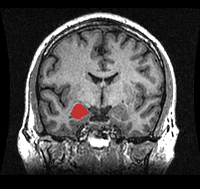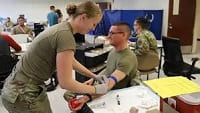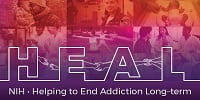
Oct 12 2019
Suicide is the second leading cause of death among all people aged 10-34 in the U.S., and a significant concern on college campuses. To better understand risk factors and inform prevention efforts, especially in underrepresented and minority populations, researchers analyzed ten years of data from the Healthy Minds Study. The research shows that suicidal ideation, planning and attempts are more common among students who believe there is significant public stigma against seeking mental health treatment. Risk is also higher among Black students, Asian-international students and sexual minority students. To learn more, please see the article in the Journal of Affective Disorders.

Oct 02 2019
The amygdala and the hippocampus — structures in the brain that are involved in emotion, learning and memory — play a role in many of mental health conditions. To learn more about how the amygdala and the hippocampus develop in early life, researchers analyzed brain scans from over 700 participants. The results indicated significant differences in growth trajectories between males and females, which may help explain why conditions develop at different times and at different rates. To learn more, please visit the NIMH website.

Oct 02 2019
Over 80% of people with schizophrenia experience auditory hallucination — hearing a sound when there is no external source. This experience can be highly distressing and can contribute to harmful behavior. New research using ultra-high field imaging suggests that auditory hallucinations are related to physical differences in the auditory cortex, an area of the brain that finishes developing very early in life. This could represent a way to identify people vulnerable to schizophrenia before they begin experiencing symptoms. To learn more, please see the article in Nature.

Sep 25 2019
An accurate diagnosis is the first step to care and recovery. Diagnosing mental illness can be difficult, however, because symptoms are primarily self-reported. To provide clinicians with an objective screening tool for Posttraumatic Stress Disorder (PTSD), researchers from NYU, Harvard University and the US Army created a biomarker panel that was approximately 80% accurate in identifying PTSD in an initial study. Although the panel requires further testing in a larger population, it is a significant step forward for objective, reliable screening tools for mental health conditions. To learn more, please see the study in JAMA.

Sep 23 2019
Genome-wide associate studies show that at least 143 chromosomal sites are involved in the development of schizophrenia. Individually, each site adds only a small fraction of risk — no single gene can explain why schizophrenia is highly inheritable. New research using advanced molecular modelling technology has shown that “expression regulators” can have a much larger impact. Working with specially lab-grown brain cells, researchers have shown that just four genes, when working in tandem, alter the expression of 1,261 others. Understanding this dynamic may help researchers identify which genes are most responsible for risk of schizophrenia. To learn more, please visit the NIMH website.

Sep 06 2019
The number of Emergency Department (ED) visits for psychiatric concerns among people aged 6-24 increased by 28% between 2011 and 2015, according to the National Hospital Ambulatory Medical Care Survey. Especially significant increases in psychiatric ED visits were seen among adolescents (aged 12-17) and Hispanic patients. This represents a growing need for mental health care and crisis management in ED settings, which are often poorly equipped for these situations — only 16% of patients in the study population were seen by a mental health professional. For more information, please visit the Suicide Prevention Resource Center.

Aug 20 2019
The Substance Abuse and Mental Health Services Administration (SAMHSA) has released the 2018 edition of the National Survey on Drug Use and Health, the nation’s primary resource for data on mental health and substance use in the United States. Encouraging trends include decreases in the use of tobacco and alcohol by pregnant women, the use of illicit drugs by young adults and the misuse of pain relievers overall. A notable area of concern is in co-occurring conditions. Approximately 9.2 million adults experienced both a mental illness and a substance use disorder in 2018. To learn more, please visit the SAMHSA website.

Aug 05 2019
When individuals are booked into a county jail they are commonly evaluated for current psychiatric symptoms and mental health history using the Brief Jail Mental Health Screen (BJMHS). To test the reliability of the BJMHS, researchers analyzed 3.5 years of data from a single large jail. The analysis showed that a person who had been booked into the jail and screened multiple times was more likely to be referred for further evaluation and treatment with each additional screening — and not because of different answers. This indicates that the BJMHS may be sensitive to reporting bias, and therefore not a consistently reliable tool. To learn more, please see the study abstract.

Jul 24 2019
NIH has announced the formation of the Justice Community Opioid Innovation Network (JCOIN) to support research on quality addiction treatment for opioid use disorder (OUD) in criminal justice settings. Individuals with OUD who are incarcerated often struggle to access appropriate treatment, putting them at increased risk for relapse or overdose when they transition back to their communities. As part of the NIH HEAL (Helping to End Addiction Long-Term) Initiative, JCOIN will establish a national network of investigators working to improve intervention and treatment strategies for this population. To learn more, please visit the NIH website.

Jul 15 2019
Nearly half of all children with mental health conditions in the U.S. do not receive treatment. Many states have established telephone hotlines that allow primary care doctors to virtually consult with a child psychiatrist, reducing the need for specialist appointments. Using data from the National Survey of Children’s Health, NIH-funded researchers at the RAND Corporation have shown that children living in states where this service is available are more likely to receive mental health care. This evidence supports further expansion of telepsychiatry to reduce the treatment gap. To learn more, please visit the RAND website.
NAMI HelpLine is available M-F, 10 a.m. – 10 p.m. ET. Call 800-950-6264,
text “NAMI” to 62640, or email. In a crisis, call or text 988 (24/7).